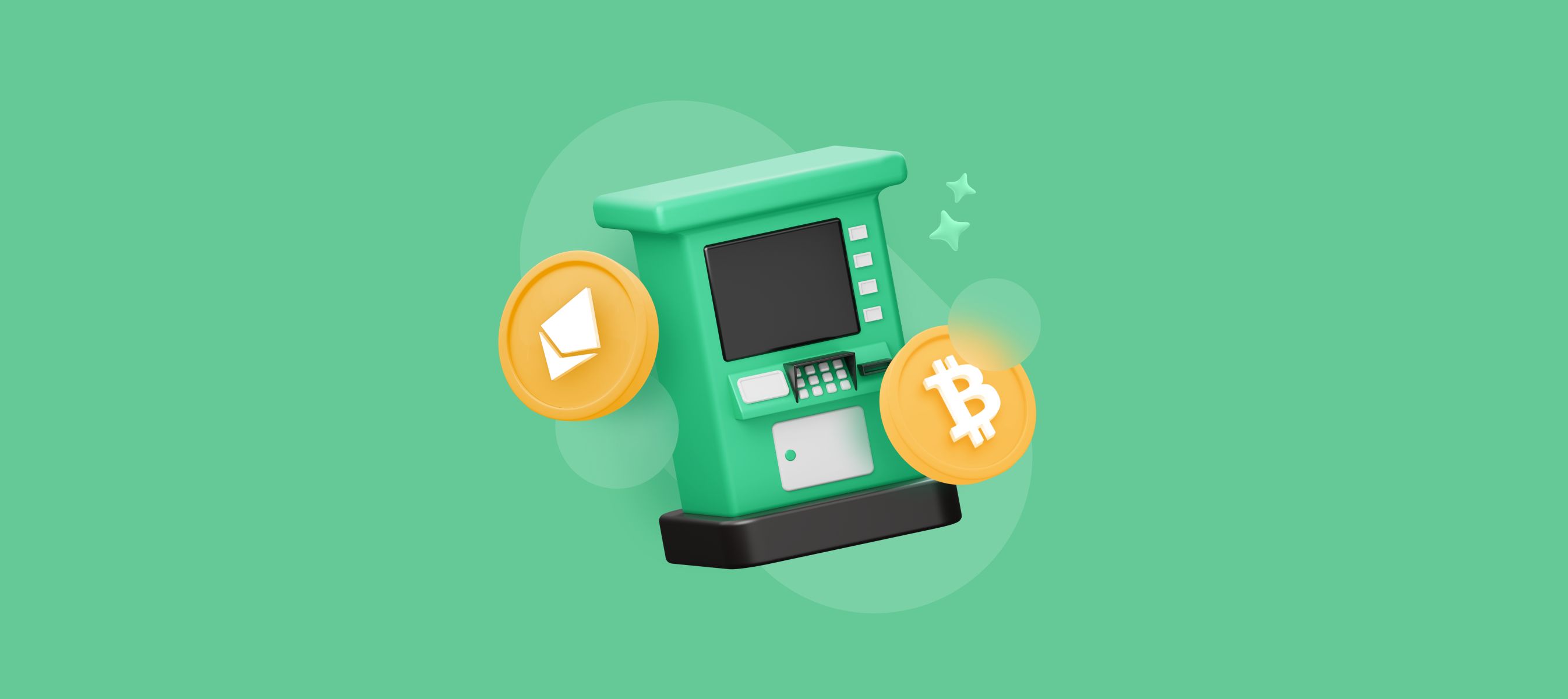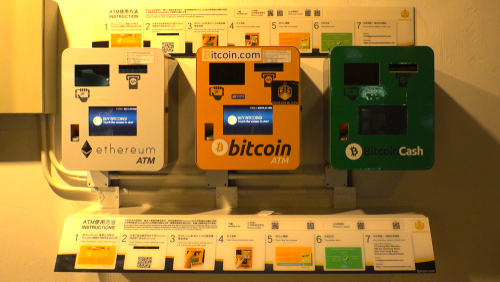Crypto ATMs In 2022

This blog post will cover:
- The lowdown on crypto ATMs
- Crypto ATM 101: how to use it?
- Pros of Crypto ATMs
- Cons of Crypto ATMs
- Find the closest crypto ATM near you
- Conclusion
It’s been a long time coming for crypto since the first-ever Bitcoin ATM was installed in Bratislava back in December 2013. Since then, the cryptosphere has grown into a trillion-dollar market cap asset class. Consequently, usage rates have skyrocketed across the board.
The only logical step for crypto-based automated teller machines (ATMs) and physical crypto kiosks would be to increase exponentially in number as cryptocurrency takes steps towards mass adoption – to the tune of an estimated 50,000 crypto ATMs worldwide and counting.
The lowdown on crypto ATMs
In essence, a crypto ATM is an automated terminal that enables individuals to buy cryptocurrencies like Bitcoin, Ethereum, and others using a bank-issued credit or debit card, or cash.
They look like a typical cash machine or stand-alone kiosk that might be built into the wall. Crypto ATMs are an easy and familiar way for individuals to convert their fiat into crypto without having to go through hoops that the less tech-savvy might not be comfortable with taking. It’s as simple as withdrawing money from your bank card.
Crypto ATM 101: how to use it?
In principle, all crypto ATMs connect to a decentralized digital ledger that allows individuals to buy digital currencies and transfer them to a cryptocurrency wallet of their choice.
While steps may vary depending on the crypto ATM provider, in general, crypto ATMs work in the following manner:
- Creating a crypto wallet. If you don’t already have a crypto wallet yet, you’ll need to create one to buy or sell crypto through a crypto ATM. Some providers may require you to use a particular crypto wallet app before using their ATMs.
- Finding a crypto ATM. Crypto ATMs can be found in high-volume foot traffic areas, such as airports, city centers, convenience stores, and gas stations.
- Following crypto ATM instructions. You will be guided through the process using on-screen instructions. This will include some form of identity verification (such as a one-time password sent to your phone). Then, it will typically involve linking your crypto wallet by scanning a QR code or entering a numeric code to complete your buy/sell transaction.
- Waiting for transaction confirmation. Transactions carried out using a crypto ATM takes from five minutes to an hour as they go through on-chain verification. You will see your funds in your crypto wallet or be able to withdraw in fiat once complete.

Pros of Crypto ATMs
As cryptocurrency adoption grows, so does the demand for a faster, safer, and more straightforward way to buy crypto. Crypto ATMs offer several advantages not just to cryptocurrency fans, but also to first-timers such as:
- Simplicity and convenience. If you’ve ever had to jump through different technical hoops buying crypto on an exchange or a peer-to-peer marketplace, you’ll be surprised how easy it is to use a crypto ATM. It’s just like using any regular banking ATM – insert your card, enter your wallet details, and you’re set.
- Accessibility. Crypto ATMs are a fast and accessible way to buy cryptocurrencies or exchange them for fiat. It takes just minutes to complete transactions, and doesn’t require the maze of KYC requirements, different processing times, and limits that exchanges impose.
- Increased privacy. All you need is a digital crypto wallet to begin using a crypto ATM, and the identity verification/security protocols in place aren’t as tedious as using a peer-to-peer market.
- User-friendly. Less tech-savvy individuals will find buying and selling crypto through ATMs much less daunting. It also limits the risk of losing funds through scams and making costly mistakes and typographical errors. However, don’t lose vigilance — pay attention to every detail, as you're still dealing with funds.
Cons of Crypto ATMs
While crypto ATMs bring about salient advantages, it must be noted that they are evolving technologies. That said, here are some of its facets that could be improved:
- High transaction fees. The most grating complaint crypto ATM users have is the high transaction fees they charge, ranging from 9-30% per transaction. However, the fees are expected to decrease as demand for crypto ATMs increases and competition between service providers tightens.
- Downtime and delays in processing. Crypto ATMs are subject to service downtimes due to technical malfunctions, processing errors, or coin shortages, just as traditional ATMs are. Improvements are expected as crypto ATM technology matures.
- Limited availability. Crypto ATMs, despite increasing in number in the past decade, aren’t as ubiquitous as banking ATMs. They might be located in hard-to-reach areas or not always in the immediate vicinity anytime you need one. However, crypto ATMs now number 50,000 and counting, and there will most likely be one near you as adoption trends upwards.
Find the closest crypto ATM near you
Searching for a nearby crypto ATM? Coin ATM Radar is an online directory that lists vetted Bitcoin and other cryptocurrency ATM locations worldwide. The directory also includes listings for crypto ATMs for multiple cryptocurrencies, such as Ethereum, Litecoin, and Tether. Another similar resource is Bitcoin ATM Map. Double-check transaction fees as they may vary depending on the crypto ATM service provider.
Conclusion
Crypto ATMs are steadily increasing in number and adoption as they provide a convenient, secure way to buy and sell cryptocurrencies for fiat and vice-versa in a familiar manner. It’s not hard to see why they will become a more common sight in cities worldwide as crypto adoption increases amid skyrocketing usage rates. However, if there’s no crypto ATM nearby, you can always rely on SimpleSwap and buy, sell or exchange cryptocurrencies without leaving the couch.
SimpleSwap reminds you that this article is provided for informational purposes only and does not provide investment advice. All purchases and cryptocurrency investments are your own responsibility.

